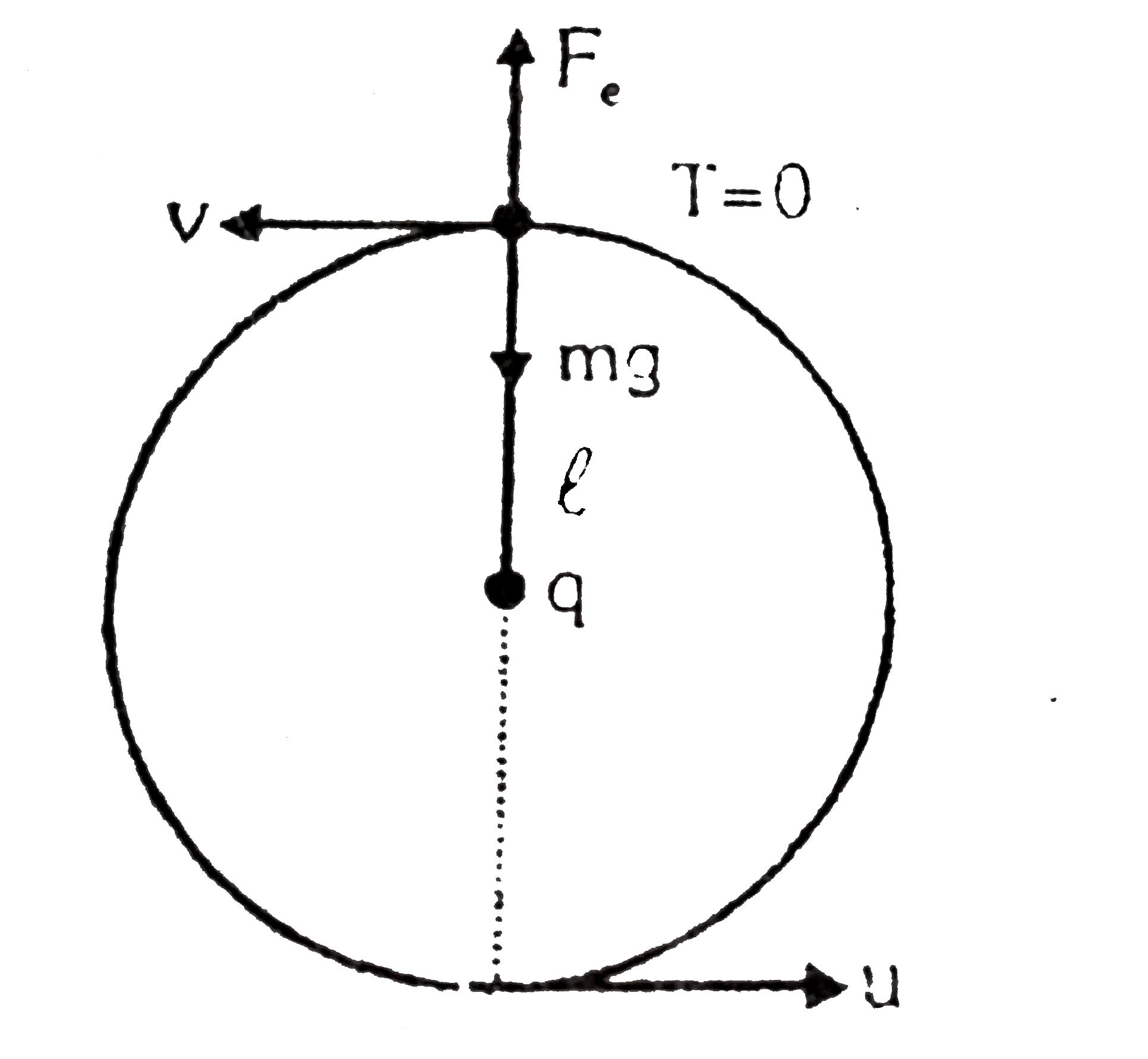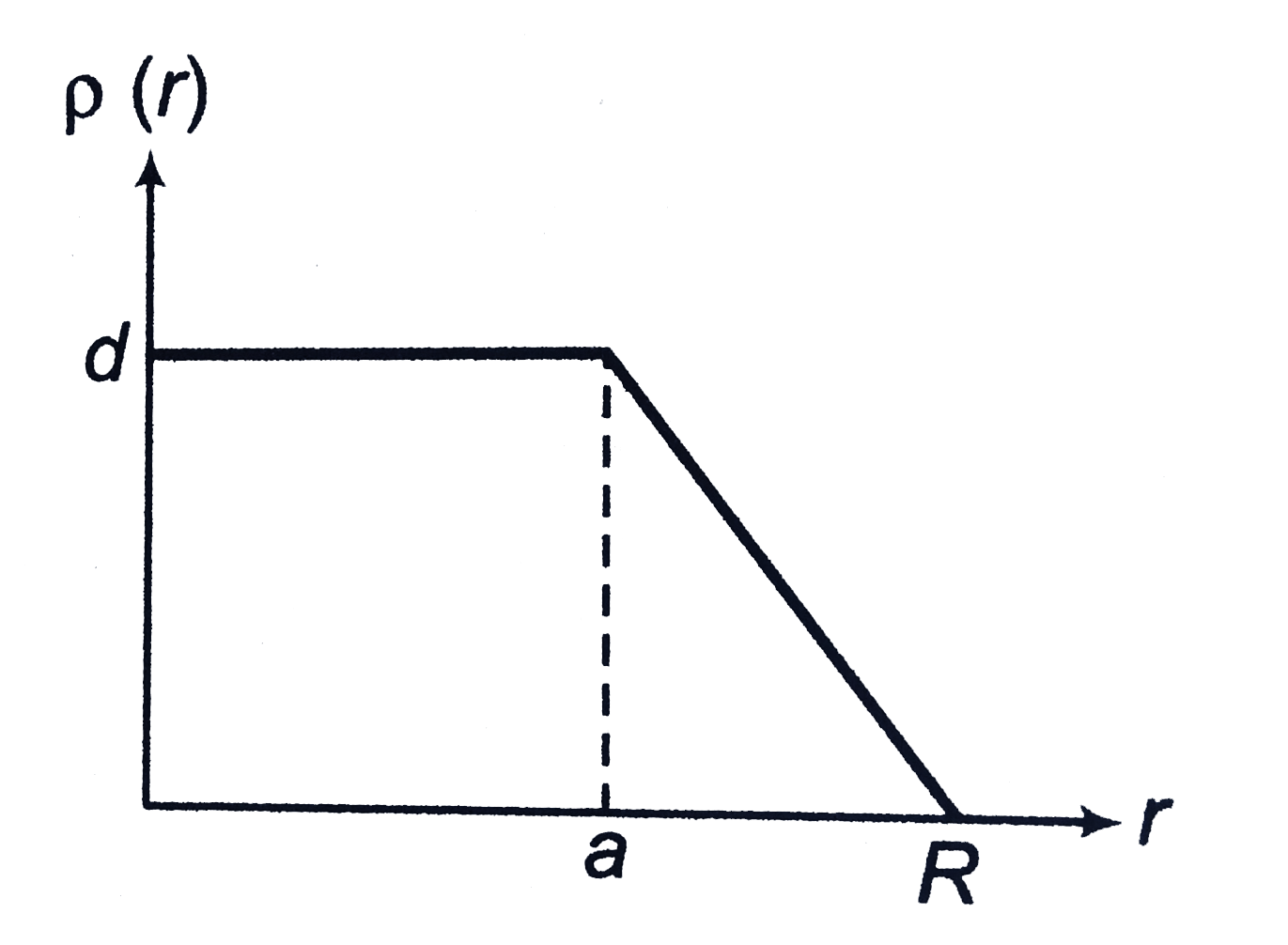A small ball if mass 2×10−3Kg having a charges of 1μC is suspended by a string of length 0.8m Another identical ball having the same charge is kept at the point of suspension . Determine the minimum horizontal velocity which should be imparted to the lower ball so that it can make complete revolution .Solution in Gujrati
The correct Answer is:5.86m/s
Given : q=1μC=10−6C

m=2×10−3 kg and l=0.8m
Let u be the speed of the particle at its lowest point and v its speed at high point. At highest point three forces are acting on the particle.
(i) Electrostatic repulsion
Fe−14πε0=q2l2 (outwards)
(ii) Weight W=mg (inwards)
(iii) Tension T (inwards)
T=0, if the particle has just to complate the circle and the necessary centripetal force provided by
W−Fe i.e., mv2l=W−Fe
⇒v2=lm(mg−14πε0×q2l2)
v2=0.82×103⎛⎝2×103×10−9.0×109×(10−6)2(0.8)2⎞⎠
⇒v2=2.4m2/s2 ...(i)
Now, the electrostatic potential energy at the lowest and highest points are equal. Hence, from conservation of mechanical energy.
Increase in gravitational potential energy
= Decrease in kinetic energy
⇒mg(2l)=12m(u2−v2)⇒u2−v2=4gl
Substituting the values of v2 from Eq (i), we get
u2=2.4+4(10)(0.8)=34.4m2/s2
∴u=5.86m/s
Therefore minimum horizontal velocity imparted to the lower ball, so that it can make complete revolution, is 5.86m/s
Topper's Solved these Questions
- MISCELLANEOUSBOOK - ALLEN CHAPTER - MISCELLANEOUSEXERCISE - PHY
68 Videos
- MISCELLANEOUSBOOK - ALLEN CHAPTER - MISCELLANEOUSEXERCISE - EXERCISE-1
121 Videos
- MISCELLANEOUSBOOK - ALLEN CHAPTER - MISCELLANEOUSEXERCISE - LINKED COMPREHENSION TYPE
3 Videos
- KINEMATICS (MOTION ALONG A STRAIGHT LINE AND MOTION IN A PLANE)BOOK - ALLEN CHAPTER - KINEMATICS (MOTION ALONG A STRAIGHT LINE AND MOTION IN A PLANE)EXERCISE - BEGINNER S BOX-7
8 Videos
- PHYSICAL WORLD, UNITS AND DIMENSIONS & ERRORS IN MEASUREMENT BOOK - ALLEN CHAPTER - PHYSICAL WORLD, UNITS AND DIMENSIONS & ERRORS IN MEASUREMENT EXERCISE - EXERCISE-IV
7 Videos
Similar Questions
Find roots equation 2x2−x−3=0.
View SolutionIf the vectors →a,→b,and→c form the sidesBC,CAandAB, respectively, of triangle ABC,then
View SolutionThe nuclear charge (Ze) is non uniformlly distribute with in a nucleus of radius r. The charge density ρ(r) (charge per unit volume) is dependent only on the radial distance r form the centre of the nucleus s shown in figure. The electric field is only along the radial direction.

The electric field at r=R is
View SolutionA football player kicks a ball at an angle of 30∘ with an initial speed of 20 m/s. Assuming that the ball travels in a vertical plane, calculate (a) the time at which the ball reaches the highest point (b) the maximum height reached (c) the horizontal range of the ball (d) the time for which the ball is in the air, (g=10m/s2)
View SolutionAssertion : Gravitational forces do not depend on the medium between the masses.
Reason : Mediating particle responsible for gravitational force is graviton.
View SolutionA small ball of mass 2×10−3kg, having a charge 1μC, is suspended by a string of length 0.8m. Another identical ball having the same charge is kept at the point of suspension. Determine the minimum horizontal velocity that should be imparted to the lower ball so that it can make a complete revolution.
View SolutionA sphere is suspended by a thread of length l. What minimum horizontal velocity has to be imparted the ball for it to reach the height of the suspension?
View SolutionA small ball if mass 2 xx 10^(-3) Kg having a charges of 1 mu C is suspended by a string of length 0. 8 m Another identical ball having the same charge is kept at the point of suspension . Determine the minimum horizontal velocity which should be imparted to the lower ball so tht it can make complete revolution .
View SolutionA small ball of mass m having charge q is suspended by a string of length L . Another identical ball having the same charge is kept at the point of suspension. Determine the minimum horizontal velocity which should be imparted to ball at lowest point so that it can make complete revolution.
View SolutionA small positively charged ball of mass m is suspended by an insulating thread of length L. This ball remains in equilibrium with string horizontal when another small charged ball is placed exactly at a distance L below the point of suspension of the first ball. The second ball is slowly moved away from the first ball to a far away point. (The second ball is moved horizontally so that the first ball does not accelerate). As a result the first ball lowers down to the original position of the second ball and the string become vertical. Find the work done by the external agent in removing the second ball.

View SolutionA ball of mass m with a charge q can rotate in a vertical plane at the end of a string of length l in a uniform electrostatic field whose lines of force are directed upwards. What horizontal velocity must be imparted to the ball in the upper position so that the tension in the string in the lower position of the ball is 1.5 times than the weight of the ball?
View SolutionThree small balls, each of mass 10 g , are suspended from a common point by 1-m silk threads . The balls are identically charged and hung at the corners of an equiliteral triangle of 0.1 m. What is the charge on each ball ?
View SolutionA spere is suspended by a thread of length l. What minimum horizontal velocity has to be imparted to the ball for it to reach the height of the suspension?
View SolutionA small ball of mass 2×10−3 kg having a charge of 1μC is suspended by a string of length 0.8 m. Another identical ball having the same charge is kept at the point of suspension. Determine the miniumum horizontal velocity which should be imparted to the lower ball, so that it can make complete revolution.
View Solution2×10−3 किग्रा द्रव्यमान की एक छोटी मद जिस पर माइक्रोकृलॉम (μC) का आवेश है, 0.8 मी लम्बी डोरी से लटकी है। एक वैसी ही दूसरी गेंद जिस पर उतना ही आवेश है, निलम्बन बिन्दु (point of suspension) पर स्थित है वह न्यूनतम क्षैतिज वेग ज्ञात कीजिये जिसे निचली गेंद को देने पर, गेंद का एक पूरा चक्कर लगा सके।
View Solution
